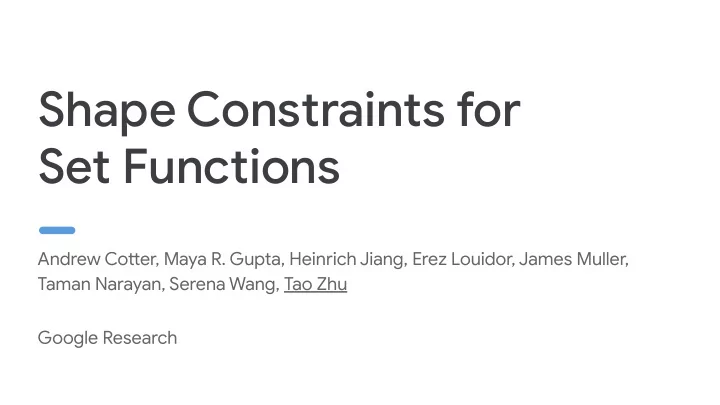

Shape Constraints for Set Functions Andrew Cotuer, Maya R. Gupta, Heinrich Jiang, Erez Louidor, James Muller, Taman Narayan, Serena Wang, Tao Zhu Google Research
Motivation ● Problem : Learn a set function to predict a label given a variable-size set of feature vectors.
Motivation ● Problem : Learn a set function to predict a label given a variable-size set of feature vectors. ● Use Case: Classify if a recipe is French given its set of ingredients.
Motivation ● Problem : Learn a set function to predict a label given a variable-size set of feature vectors. ● Use Case: Classify if a recipe is French given its set of ingredients. ● Use Case: Estimate label given compound sparse categorical features . ○ Predict if a KickStarter campaign will succeed given its name “ Superhero Teddy Bear ”.
Motivation How likely a campaign succeeds given its name “ Superhero Teddy Bear ”? E (Y | “Superhero Teddy Bear”)
Motivation How likely a campaign succeeds given its name “ Superhero Teddy Bear ”? E (Y | “Superhero”) = 0.3 E (Y | “Superhero Teddy Bear”) Mean ({0.3, 0.9}) = 0.6 Min ({0.3, 0.9}) = 0.3 Max ({0.3, 0.9}) = 0.9 E (Y | “Teddy Bear”) = 0.9 Median ({0.3, 0.9}) = 0.6
Motivation How likely a campaign succeeds given its name “ Superhero Teddy Bear ”? E (Y | “Superhero”) = 0.3 Count (“Superhero”) = 100 0.3 *100 + 0.9 *50 E (Y | “Superhero Teddy Bear”) 100 + 50 E (Y | “Teddy Bear”) = 0.9 Count (“Teddy Bear”) = 50
Motivation How likely a campaign succeeds given its name “ Superhero Teddy Bear ”? E (Y | “Superhero”) = 0.3 Count (“Superhero”) = 100 0.3 *100*1 + 0.9 *50*2 E (Y | “Superhero Teddy Bear”) Size (“Superhero”) = 1 100*1 + 50*2 E (Y | “Teddy Bear”) = 0.9 Count (“Teddy Bear”) = 50 Size (“Teddy Bear”) = 2
Motivation How likely a campaign succeeds given its name “ Superhero Teddy Bear ”? E (Y | “Superhero”) = 0.3 Count (“Superhero”) = 100 0.3 *100*1 + 0.9 *50*2 E (Y | “Superhero Teddy Bear”) Size (“Superhero”) = 1 100*1 + 50*2 E (Y | “Teddy Bear”) = 0.9 Not flexible enough! Count (“Teddy Bear”) = 50 Size (“Teddy Bear”) = 2
Motivation How likely a campaign succeeds given its name “ Superhero Teddy Bear ”? E (Y | “Superhero”) = 0.3 Count (“Superhero”) = 100 E (Y | “Superhero Teddy Bear”) Learned Set Function ({ Size (“Superhero”) = 1 [0.3, 100, 1], [0.9, 50, 2]}) E (Y | “Teddy Bear”) = 0.9 Count (“Teddy Bear”) = 50 Size (“Teddy Bear”) = 2 [Deep Sets, Zaheer et al. 2017]
Motivation How likely a campaign succeeds given its name “ Superhero Teddy Bear ”? E (Y | “Superhero”) = 0.3 Count (“Superhero”) = 100 E (Y | “Superhero Teddy Bear”) Learned Set Function ({ Size (“Superhero”) = 1 [0.3, 100, 1], [0.9, 50, 2]}) E (Y | “Teddy Bear”) = 0.9 Count (“Teddy Bear”) = 50 Too flexible Size (“Teddy Bear”) = 2 “over-fit”
Motivation How likely a campaign succeeds given its name “ Superhero Teddy Bear ”? E (Y | “Superhero”) = 0.3 Count (“Superhero”) = 100 E (Y | “Superhero Teddy Bear”) Learned Set Function ({ Size (“Superhero”) = 1 [0.3, 100, 1], [0.9, 50, 2]}) E (Y | “Teddy Bear”) = 0.9 Count (“Teddy Bear”) = 50 Size (“Teddy Bear”) = 2 Set function properties for more regularization and better interpretability ● Monotonicity : output does not decrease as E(Y | “Superhero”) or E(Y | “Teddy Bear”) increases. ● Conditioning : conditioning feature (count/size) tells how much to trust primary feature.
Motivation How likely a campaign succeeds given its name “ Superhero Teddy Bear ”? E (Y | “Superhero”) = 0.3 Count (“Superhero”) = 100 E (Y | “Superhero Teddy Bear”) Learned Set Function ({ Size (“Superhero”) = 1 [0.3, 100, 1], [0.9, 50, 2]}) E (Y | “Teddy Bear”) = 0.9 Count (“Teddy Bear”) = 50 Size (“Teddy Bear”) = 2 Set function properties for more regularization and better interpretability ● Monotonicity : output does not decrease as E(Y | “Superhero”) or E(Y | “Teddy Bear”) increases. ● Conditioning : conditioning feature (count/size) tells how much to trust primary feature. Can we learn flexible set functions while satisfying such properties?
Our approach: DLN with Shape Constraints Using Deep Lattice Network (DLN) (You et al. 2017) 1-D PLF x 1 x 1 [1] x 1 [2] x 1 [3] μ 𝜚 f(x) μ ρ RATER CONFIDENCE x 2 x 2 [1] RATING Multi-D Lattice x 2 [2] x 2 [3] Example lattice function 𝜚 ● Monotonicity ● Conditioning (Edgeworth) ● Conditioning (Trapezoid)
Our approach: DLN with Shape Constraints Using Deep Lattice Network (DLN) (You et al. 2017) 1-D PLF x 1 x 1 [1] x 1 [2] x 1 [3] μ 𝜚 f(x) μ ρ RATER CONFIDENCE x 2 x 2 [1] RATING Multi-D Lattice x 2 [2] x 2 [3] Example lattice function 𝜚 ● Monotonicity ● Conditioning (Edgeworth) ● Constrained empirical risk minimization based on SGD ● Shapes constraints work for normal functions ● Conditioning (Trapezoid) (set size = 1) using DLN as well
Semantic Feature Engine Estimate E(Y | “Superhero Teddy Bear”) ● E[Y |T B] E[Y | T B] S T B Tokenize Estimate Filter Set Function count S T E[Y | S] order T B “S T B” E[Y | “S T B”] E[Y | T] S E[Y | B] E[Y | S] T count B order ● Shape constraints ○ Monotonicity : Output monotonically increasing wrt. each ngram estimate. ○ Conditioning : Trust more frequent ngrams more... ● Similar accuracy as Deep Sets (Zaheer et al. 2017) and DNN, but with guarantees on model behavior producing better generalization and more debuggability.
Poster Tonight 06:30 -- 09:00 PM @ Pacific Ballroom #127
Recommend
More recommend